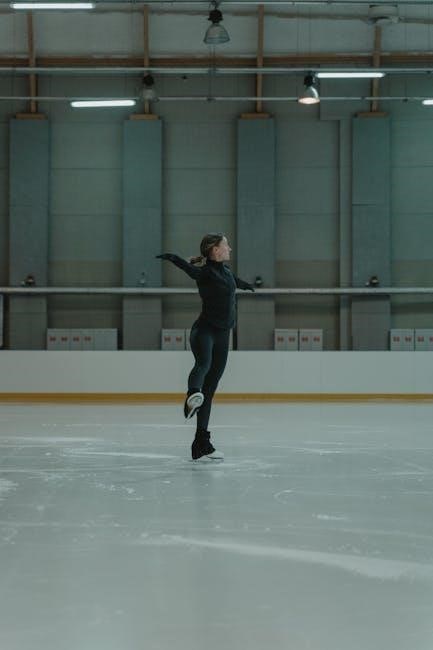Radial nerve palsy is a condition caused by damage to the radial nerve, leading to loss of motor function and sensation. It often results from fractures, compression, or trauma, causing symptoms like wrist drop and weakened grip. Early intervention, including targeted exercises, is crucial for recovery and restoring hand and arm functionality.
1.1 Definition and Overview
Radial nerve palsy is a condition characterized by damage to the radial nerve, impairing its function. It affects the nerve’s ability to control wrist and finger movements, often leading to symptoms like wrist drop. The radial nerve, essential for hand and arm mobility, can be injured due to fractures, compression, or trauma, necessitating targeted exercises for recovery.
1.2 Causes and Risk Factors
Radial nerve palsy typically arises from direct trauma, fractures, or prolonged nerve compression. Risk factors include repetitive arm movements, prolonged pressure on the nerve, and certain occupations or activities. The radial nerve’s proximity to bones makes it vulnerable, especially during fractures or nighttime compression, which can lead to temporary or permanent nerve damage and functional impairment.
1.3 Symptoms and Diagnosis
Common symptoms of radial nerve palsy include wrist drop, weakened grip, and loss of sensation on the back of the hand. Diagnosis involves physical examination, nerve conduction studies, and imaging to confirm nerve damage. Early identification of symptoms is crucial for effective treatment and rehabilitation, ensuring optimal recovery outcomes.
Importance of Exercises in Radial Nerve Palsy Rehabilitation
Exercises play a vital role in improving mobility, strength, and functionality in radial nerve palsy patients. They help prevent stiffness, promote nerve recovery, and restore daily activity performance.
2.1 Role of Physical Therapy
Physical therapy is essential in radial nerve palsy rehabilitation, focusing on restoring motor function and reducing symptoms. Tailored exercises, nerve gliding techniques, and manual therapy improve mobility and strength. Therapists also address pain and swelling, promoting faster recovery and preventing long-term damage. Regular sessions enhance functional abilities, aiding patients in regaining independence in daily activities.
2.2 Benefits of Consistent Exercise Routine
A consistent exercise routine in radial nerve palsy enhances nerve mobility, strengthens muscles, and improves joint flexibility. Regular practice reduces recovery time, minimizes stiffness, and restores functional abilities. It also prevents atrophy, promoting better grip strength and wrist extension. Over time, consistent effort leads to significant improvements in motor function and overall quality of life for patients.

Stretching Exercises for Radial Nerve Palsy
Stretching exercises focus on improving wrist, forearm, and finger flexibility. Techniques like wrist extensions and nerve gliding help reduce stiffness and enhance nerve mobility, aiding recovery.
3.1 Wrist and Forearm Stretches
Wrist and forearm stretches are fundamental in radial nerve palsy rehabilitation. Exercises like wrist extensions and flexions improve flexibility and reduce stiffness. Forearm stretches target the extensor muscles, enhancing mobility. Regular practice helps restore range of motion and prepares the arm for strengthening exercises. Always perform stretches gently to avoid further injury. Consulting a physical therapist ensures proper technique and progression.
3.2 Finger Extensor Stretches
Finger extensor stretches target the muscles responsible for finger extension, often weakened in radial nerve palsy. Exercises involve gently stretching the fingers back and holding the position. This improves tendon mobility and reduces stiffness. Regular stretching enhances grip strength and dexterity, aiding in daily activities. Consistency and proper form are key to maximizing benefits and avoiding setbacks during recovery.

Strengthening Exercises
Strengthening exercises are crucial for restoring wrist and hand function in radial nerve palsy. They focus on improving muscle endurance and power, aiding recovery and daily activities.
4.1 Wrist Extension Strengthening
Wrist extension strengthening is a key exercise for radial nerve palsy recovery. Using light weights or resistance bands, patients perform wrist lifts in a seated position, holding for 5 seconds. Aim for 3 sets of 10-15 repetitions daily. This exercise targets the extensor muscles, improving wrist mobility and grip strength. Consistency is vital, especially under a physical therapist’s guidance, to restore functional movement and reduce wrist drop.
4.2 Grip Strengthening Exercises
Grip strengthening exercises, such as squeezing a rubber ball or using a hand grip device, are essential for radial nerve palsy recovery. Patients should perform 3 sets of 10-15 repetitions daily, focusing on slow, controlled squeezes. Progressing to light weights or resistance bands can enhance finger and forearm muscle strength, improving overall hand function and dexterity. Regular practice helps restore grip power and coordination.

Nerve Gliding Exercises
Nerve gliding exercises improve radial nerve mobility, reducing tension and promoting recovery. These exercises involve controlled arm movements to guide the nerve through its natural path smoothly.
5.1 Radial Nerve Mobilization Techniques
Radial nerve mobilization techniques involve specific exercises to enhance nerve movement and reduce compression. Activities like the “figure-eight” arm swing and wrist rotations help the nerve glide smoothly through the arm, improving mobility and alleviating symptoms. These exercises are designed to restore normal nerve function and promote recovery in radial nerve palsy patients.
5.2 Exercises to Improve Nerve Mobility
Exercises to improve nerve mobility focus on enhancing the radial nerve’s ability to glide through tissues. Techniques include wrist rotations, finger extensions, and gentle arm swings. These movements reduce nerve compression and promote recovery. Regular practice helps restore nerve function, improving wrist and hand mobility, and is essential for managing radial nerve palsy effectively.

Activity Modification and Ergonomic Tips
Modify activities to avoid repetitive strain and awkward postures. Use ergonomic tools and adjust workspaces to reduce pressure on the radial nerve, promoting recovery and comfort.
6.1 Avoiding Repetitive Strain
Avoiding repetitive strain is crucial in radial nerve palsy management. Repetitive wrist or forearm movements can worsen symptoms. Modify tasks to reduce overuse, and incorporate regular breaks. Ergonomic adjustments, such as using properly sized tools, can minimize strain. Avoid activities that involve prolonged gripping or twisting, as these can exacerbate nerve pressure and slow recovery. Prioritize gentle, controlled movements to protect the nerve during daily activities.
6.2 Proper Posture and Workspace Setup
Proper posture and workspace setup are vital to prevent radial nerve strain. Maintain a neutral wrist alignment during tasks to avoid compression. Use ergonomic tools and adjust your workspace to reduce reaching or bending. Ensure your chair and desk height promote upright posture, minimizing forearm strain. These adjustments help prevent further nerve irritation and support overall recovery and comfort during daily activities.

Role of Physical Therapy in Recovery
Physical therapy is crucial for radial nerve palsy recovery, offering tailored exercise plans, nerve gliding techniques, and assistive devices to restore function and mobility effectively.
7.1 Customized Exercise Plans
Customized exercise plans are tailored to address specific deficits in radial nerve palsy, focusing on wrist extension, grip strength, and nerve mobility. These plans, designed by physical therapists, adapt to individual progress, ensuring optimal recovery. They often combine stretching, strengthening, and nerve gliding exercises to enhance functional outcomes and reduce the risk of further complications.
Assistive devices, such as wrist splints and adaptive utensils, play a vital role in radial nerve palsy recovery. Splints support the wrist, improving grip and reducing strain, while ergonomic tools enable individuals to perform daily tasks with greater ease. These devices complement exercise routines, enhancing functional independence and aiding in the rehabilitation process effectively.

Alternative Therapies and Modalities
7.2 Use of Assistive Devices
Assistive devices, such as wrist splints and adaptive utensils, aid in radial nerve palsy recovery by providing stability and improving functionality. These tools enhance grip strength and dexterity, allowing individuals to perform daily tasks with greater ease and independence, complementing exercise routines for optimal rehabilitation outcomes.
8.1 Yoga and Flexibility Training
Yoga and flexibility training enhance radial nerve palsy recovery by improving joint mobility and reducing stiffness; Gentle poses and breathing techniques promote nerve health and circulation, aiding in pain reduction and functional improvement; These practices complement physical therapy, offering a holistic approach to restoring arm and hand function without excessive strain.
8.2 Massage Therapy for Nerve Recovery
Massage therapy aids in radial nerve recovery by enhancing blood circulation and reducing muscle tension. Techniques like myofascial release and gentle nerve gliding strokes can alleviate pressure on the radial nerve, promoting healing and restoring sensation. Regular massage sessions complement exercises, supporting nerve regeneration and improving overall arm and hand function for patients with radial nerve palsy.
Recovery Timeline and Progression
Recovery from radial nerve palsy varies, with initial improvements seen within weeks to months. Nerve healing occurs at approximately 1mm/day, requiring consistent effort for full functional restoration.
9.1 Expected Outcomes of Exercise Programs
Consistent exercise programs for radial nerve palsy typically lead to improved wrist and hand function, reduced stiffness, and enhanced grip strength. Patients often experience a noticeable reduction in pain and improved nerve mobility over time. Full recovery may take several months, but adherence to a structured routine significantly accelerates progress and restores functional abilities.
9.2 Monitoring Progress and Adjusting Exercises
Regularly monitoring progress in radial nerve palsy exercises is essential to ensure effectiveness. Assessments of strength, range of motion, and functional improvement should be conducted periodically. Adjustments to the exercise routine may be necessary based on individual recovery pace and specific needs. A healthcare provider or physical therapist can provide personalized guidance to optimize rehabilitation outcomes.

Preventing Recurrence
Preventing radial nerve palsy recurrence involves consistent exercise, proper ergonomics, and avoiding repetitive strain. Regular strengthening and stretching routines, along with lifestyle modifications, promote long-term nerve health.
10.1 Long-Term Exercise and Stretching
Long-term exercise and stretching are essential for maintaining nerve health and preventing radial nerve palsy recurrence. Regular wrist extensions, forearm stretches, and nerve gliding exercises improve mobility and strength. Consistency helps sustain recovery gains and reduces the risk of future nerve damage, ensuring optimal hand and arm functionality over time.
10.2 Lifestyle Modifications for Nerve Health
Lifestyle changes play a vital role in supporting nerve health and preventing radial nerve palsy recurrence. Maintaining a balanced diet rich in vitamins B and E, staying hydrated, and managing stress are key. Avoiding smoking and excessive alcohol consumption also promotes nerve regeneration. Regular physical activity and proper posture further contribute to long-term nerve health and overall well-being.
Effective exercises and therapies for radial nerve palsy focus on restoring function and mobility. Consistent routines and professional guidance are essential for recovery and nerve health.
11.1 Summary of Key Exercise Strategies
Key strategies include wrist and forearm stretches to improve flexibility, grip strengthening for functional recovery, and nerve gliding exercises to enhance mobility. Consistent routines and professional guidance are crucial for optimal recovery, ensuring exercises are tailored to individual needs and progress.
11.2 Importance of Patient Compliance and Professional Guidance
Adherence to prescribed exercises and seeking professional advice are vital for effective recovery. A physical therapist can tailor exercises to individual needs, ensuring safety and progress. Patient compliance maximizes outcomes, while professional guidance addresses challenges and prevents complications, fostering a successful rehabilitation journey.
